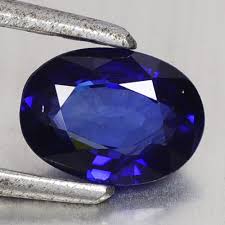SAPPHIRE
Within the group of precious minerals of the Corundum family there is sapphire, with its characteristic blue color – a result of trace amount of certain oxides. Together with rubies and emeralds, sapphires are among the most widely used gemstones in jewelry.
The name comes from the Hebrew word ‘chappir’ (ספיר = Safir), which means ‘neat’.
Although they come in a wide range of colors from transparent to yellow, orange, pink and various fancy combinations, its better known blue veriety is due to its chemical composition – Aluminum Oxide (Formula Al2O3).
It is the second hardest mineral (according to the Mohs scale, sapphire’s hardness is 9 out of 10); besides, it is also quite heavy (between 3.90 and 4.10) due to its mineral composition: aluminum, iron and titanium.
Sapphires are formed in the depths of the lithosphere, often located in magmatic rocks.
The largest producers are in Africa; there are also deposits in Burma, India, Thailand, Australia, Nigeria, Brazil, Colombia, Tanzania, the United States and Vietnam. Although there are also large amounts of this mineral in Antarctica, its exploitation has been limited not to disturb the delicate ecological balance of the area.
SYNTHETIC
Its synthetic version production began in the United States in the 1940s, achieving a really surprising imitation at a much lower cost. The process involves taking fine alumina powder and melting it in a huge flame of explosive gas. Alumina is progressively deposited in the form of tear material of this mineral. These synthetic sapphires are very similar in appearance and qualities to natural sapphires, that is why the help of an expert is necessary to differentiate natural sapphires from synthetic ones.
QUALITY CHARACTERISTICS
As with other precious stones its value and price is largely governed by characteristics such as color, transparency, size and quality of its size. The best color is considered to be the deep blue one with a violet shade and the second most valuable color in the sapphire is blue with a slightly grayish tone. Another important parameter is the degree of purity. The inclusions in the sapphire take away a lot of its value. As in the case of ruby, sapphire gets a much higher value when certified that it has not been treated.
FAMOUS SAPPHIRES

(By This picture was taken by Daniel Torres, Jr. on January 14, 2007. – Transfered from en.wikipedia Transfer was stated to be made by User:Multichill., Attribution, https://commons.wikimedia.org/w/index.php?curid=3203393)
The Star of India is among the largest sapphire that has been found in the world. This sapphire weighs 563,35 carats, it is now in the American Museum of Natural History.
The Midnight Star – a 116.75 carat deep purple-violet star sapphire, it was discovered about three hundred years ago in Sri Lanka.
The Star of Asia weighs about 330 carats, can be found in Washington, in the same location with the Star of Artaban whose weight is 316 carats.
The Logan Sapphire has a weight of 423 carats, it is located in the Smithsonian Museum of Natural History, in Washington.
Four extremely large black star sapphires found in Rubyvale, Queensland, Australia. The Americans carved the heads of their four presidents: Lincoln, Eisenhower, Jefferson and Washington. The 4 sapphires rough carat weights were 2302, 1997, 1743, 2097. Once carved the busts of
Lincoln was 1318ct;
Washington was 1056ct;
Jefferson was 1381ct;
Eisenhower was 1444ct.
There was also a 5th huge black star sapphire that was an astounding 4180 carats uncut. The stone was cut into Martin Luther King Jr and was 3294ct. The Sapphire Rose has a diamond shape, weighs about 135.80 carats; this sapphire was owned by Louis XIV, it is currently in the National Museum of Natural History in Paris.


